-
info@aaanimalcontrol.com
Call us for help in your town
Humane Wildlife Education
How To Get Rid of Raccoons
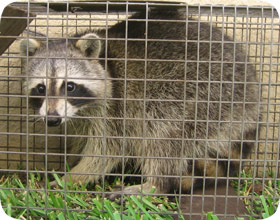 Here are the best ways to get rid of raccoons:
Here are the best ways to get rid of raccoons:
- Cage Trapping: For certain types of outdoor raccoon problems, trapping and removal is a good option. But it not always easy.
- Exclusion: If raccoons are getting in your attic or walls, or under a shed or deck, you must find the entry areas and seal them shut.
- Prevention: Keep away food sources like pet food or bird seed. Keep your garbage cans secure. A good fence can keep them at bay.
- Repellents: Do mothballs, ammonia, fox or coyote urine, or sound machines repel raccoons? No - these tactics do not alter raccoon behavior.
- In the Attic: Raccoons in the attic must be dealt with in a very careful, specific way, because there will be baby raccoons. Read about raccoons in the attic.
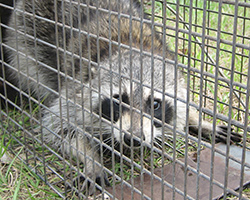 Raccoon Info: Raccoons are usually classified as a pest
species due to their habits of living in
human dwellings. The most common complaints
include the following:
Raccoon Info: Raccoons are usually classified as a pest
species due to their habits of living in
human dwellings. The most common complaints
include the following:
- Raccoons living in the attic
- Raccoons living in the chimney
- Tipping over garbage cans
- Stealing pet food or bird seed
- Sick, potentially rabid raccoon
- Presence is alarming dogs/pets
After you read the below information, in the event
that you wish to hire a raccoon removal company, you
may want to see how
much does raccoon removal cost? With example prices for different raccoon situations.
How to Get rid of them: The primary
approaches are trapping, prevention, or repellents,
as outlined and discussed below in detail.
Trapping: Trapping is always an option for
wildlife removal. However, it's not always so cut
and dry. Much of the time, simple trapping does not
solve the problem. The majority of cases of
do-it-yourself raccoon trapping have gone awry. It's
common to catch the wrong animal - a stray cat, a
skunk, or opossum, or the wrong raccoon. You want
your raccoon problem to go away - if the coon is
tipping your garbage can, pooping in your pool,
killing your ornamental fish or birds, or whatever.
But if you trap, you want to be sure to get the
right animal, in the right way, and do it legally.
It must be done correctly, with the right type of
trap - one at least 12x12x32 to hold raccoons, and
sturdy steel or solid-wall. Raccoons are very strong
and crafty and have a way of breaking out of traps.
Novices just get so many things wrong. It took me
years of trapping to learn to always get it right.
So many little factors go into successful trapping.
For more information read my raccoon
trapping guide. You have to be conscious of
the safety and welfare of the animal, and relocate
it at least ten miles away, in an acceptable
location. It's probably against the law for you
to trap and relocate raccoons if you are not
licensed - it's illegal in most states. A properly
licensed trapper, who knows wildlife and has
experience, is vaccinated against rabies, and who
can do it safely and legally, is the best option.

Raccoons in the Attic: PLEASE do not try to
trap and remove if you have raccoons in the attic.
Nine times out of ten, there's baby raccoons up
there! If you trap and remove the mother, you will
have a BIG PROBLEM on your hands, and you will
likely cause further house damage, noise, suffering
of cute little raccoons, and a terrible odor as the
babies die and decompose. Click here for my special
guide on How
to Get Raccoons Out of an Attic, the most
comprehensive guide to attic raccoon removal on the
web. This is not a job for homeowners! Call a pro!
Prevention: Now here's something anyone can
do. Secure your garbage can and strap the lid down
with bungee cords. If you want to get rid of
raccoons in your yard, don't leave out pet food.
Lock your doggie-doors. If you want to get rid of
raccoons in your house, make sure your house is
secure, with no holes or openings into the attic. If
they are getting under the house or under the deck,
you can install an exclusion barrier of steel mesh.
And remove whatever is attracting the raccoons - if
they're pooping in the pool, put a board with spikes
on the steps. If they're tearing their way into your
screened porch to swipe at your pet bird, bring the
bird inside! Common sense.
Top 10 Tips for How to Get Rid of Raccoons:
- If the raccoons are in your attic, inspect your house to identify the entry points.
- When raccoons live in your attic or any part of your house, it is almost always a female raccoon with a litter of babies. Be sure to remove the babies as well as the adult.
- You can sometimes intimidate a female and it will leave on its own with the young. Accomplish this via physical harassment and the use of raccoon eviction fluid.
- Remove the litter of baby raccoons by hand, place in a pillow case, and use them as "live bait" to lure the mother into a cage trap, in the back of a trap with a divider mechanism.
- When trapping, use a large sturdy steel cage trap, at least 12"x12"x32". Always set the trap in the shade, to prevent overheating. Make sure the trap is on a solid, level surface.
- Bait is not terribly important. Location of trap, and a sturdy set with proper tension matters more. However, avoid meat-based baits to prevent the capture of stray cats. Use marshmallows.
- If a raccoon is tipping over your garbage cans, either bring the cans indoors, or strap the lids down with bungee cords.
- If a raccoon is eating pet food or bird seed, you will need to temporarily remove these attractants from the outdoors for a period of weeks, until the raccoon gives up.
- If a raccoon is pooping in a swimming pool or trampling a garden, a physical deterrent, such as a board with nails pointing up, fencing, water sprayer, or shock track can keep them away.
- If it is legal for you to trap raccoons, and relocate them in your state, bring them at least ten miles away from the capture site to prevent them from returning.
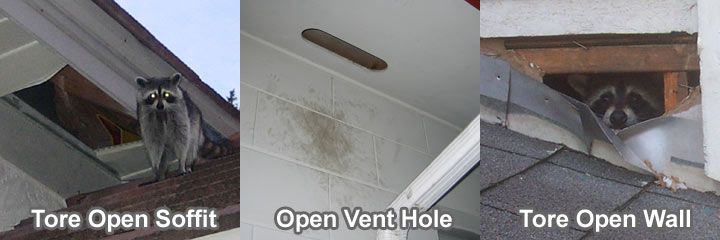
RACCOON BEHAVIOR: Raccoons are talented
animals, and very well-adapted to live in almost any
setting with ample food and water sources -
including urban and suburban areas. Raccoons have a
variety of skills that allow them to exhibit a
variety of behaviors, most revolving around the
basics: foraging for food
and seeking shelter. Regarding the former, raccoons
are omnivores, and opportunistic. They will eat
from garbage cans (which they open the lids of
or tip over) and dumpsters (which they sometimes get
stuck in), and they will often steal pet food. Dog
or cat food left outside is pretty much an open
invitation to a raccoon, as the animal has no fear
of any dog or cat, or oftentimes, human. If the pet
food is indoors, the crafty raccoon will still get
to it - they will rip open a screen to get inside
the patio where the food is laid out, and will often
find the food storage, and break into that as well.
I've frequently observed raccoons entering pet doors
and eating the pet food inside the house.
In one case, raccoons were entering the pet door,
going through the kitchen, down the hallway, across
the living room, into the parlor, and up on the
piano to the cat food bowl. Amazing! Raccoons are
primarily nocturnal, so most of this mischief
happens at night.
 Click for my raccoon removal photo gallery.
Click for my raccoon removal photo gallery.
Over 60 photographs of actual raccoon trapping and removal jobs I've done.
 Visit my awesome raccoon trapping blog!
Visit my awesome raccoon trapping blog!
Over 25 examples of specific raccoon control jobs I've done. Get ideas!
RACCOON FACTS: Raccoons are common
throughout North America. In fact, they are more
common in urban areas than in rural areas. They tend
to grow larger up north than down south. Northern
raccoons, up in the northern US and Canada can reach
over 50 pounds. Down in the south, 20 pounds is
large. They are well-known for their ringed tail and
masked
face. They are not really related to any other
mammals. They are somewhat distant relatives of
bears. They are very strong for their size. They can
swivel the hind feet around 180 degrees to descend a
tree headfirst, and are excellent climbers. Raccoons
usually give birth to 3-5 young in the spring. These
young are very cute, as so some people are tempted
to seek pet
raccoons, but their temperament isn't suitable
for a pet. They are omnivores, and eat almost
anything. They are nocturnal.
ARE THEY BAD ANIMALS? Certainly not. They
can be described as cute
and talented, and are well adapted to survive in
both the forest and the city. They get into trouble
with people because they are so adaptable, clever,
and handy. As with all animals, they usually just do
what they need to do to survive. Oftentimes this
means ripping a hole in your roof and living in your
attic. It's true that once inside, they can really
trash the place and cause damage.
They will usually rip up the duct work, tear the
insulation off of pipes, rip up wires, trample or
pull up the insulation, rip off any paper lining,
and sometimes even damage wood joists. The bigger
problem may be the biohazardous contamination they
cause. They urinate and defecate in the attic, and
the droppings
can contain raccoon roundworm - transferrable to
humans, or diseases such as canine distemper,
transferrable to your pets. They also may bring in
the fleas and other parasites associated with wild
animals. It's just the way they are. They also get
into trouble with those nimble hands. They'll break
into and open anything they can find, so people may
find the trash cans knocked down, or the pet food
bag in the garage ripped apart and other problems.
They're usually just looking for food.
BUT DON'T THEY HAVE RABIES? Many people seem
to believe that all raccoons carry rabies - a
disease that is highly misunderstood. First of all,
rabies is a virus, contracted in via an infected
animal - raccoons are not born with rabies any more
than you are. Second, if a raccoon does contract
rabies, it's going to die. It doesn't just happily
go about its business, ready to infect any person it
comes close to. Third, the virus is only
transferrable in the very short-lived contagious
stage, in which the animal is in the throes of death
- walking in circles, hind legs possibly paralyzed,
foaming at the mouth, etc. At this time, the virus
is transferrable via saliva. I, along with almost
every nuisance wildlife expert in the country, I'm
sure, am called constantly with reports of rabid
raccoons: "but I saw it outside
in the daytime!". If it looked healthy, it
didn't have contagious rabies. Sometimes raccoons
simply forage at night - after all, haven't you ever
gotten out of bed for a midnight snack? Finally, for
whatever reason, there's only been one documented
case of rabies transmission from raccoon to human in
the US. Most cases of human infection are due to
bats.
WHAT ARE THE MOST COMMON CONFLICTS? The most
common thing is a raccoon in an attic, or the soffit,
which is under the eave around the perimeter of the
attic. They will also nest in the chimney,
which is like a big hollow tree. I've seen many
cases of raccoons living and nesting inside
the walls of homes, or even between floors,
where they can be heard scratching and making noise
in the ceiling.
They will also commonly live under a shed or porch,
and if possible, under
a house. Sometimes they just scratch, poop,
and sleep on
the roof. As stated, they'll also get into all
sorts of mischief around a house or property, from
tipping garbage cans, to eating pet food, to killing
ornamental fish in ponds, to pooping in the pool,
ripping apart the screen, killing birds, etc.
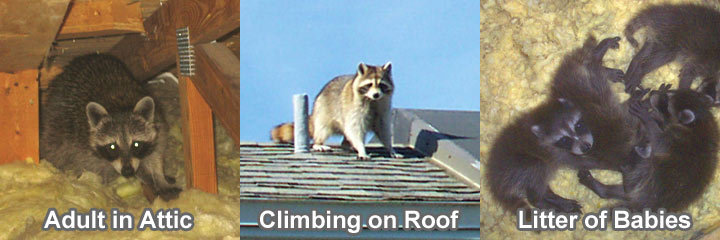
HOW DO I REMOVE THEM MYSELF? There's a
reason professional wildlife trapping companies
exist. First of all, it's probably illegal for you
to trap and remove and relocate raccoons on your own
in the state you live. In many states, because the
raccoon is a rabies vector, it's often illegal to
relocate them. Most private citizens don't have the
means to humanely euthanize trapped wildlife and
properly dispose of or cremate the carcass. Other
regional laws regarding wildlife trapping may
prevent you from self-trapping as well. Second of
all, for those that lack experience, mistake abound
in raccoon
capture. I've seen firsthand my share of big
mistakes - from catching non-target animals like the
neighbor's cat, to setting the trap in the wrong
area and seeing a trapped raccoon tear up adjacent
screens or wires, to causing the animal to suffer,
to being badly bitten while attempting to move the
trap. Sometimes wildlife trapping seems simple, but
it's a science, and there's a lot of intangibles
that a professional recognizes ahead of time, and a
novice simply does not know about. One of the
biggest problems I see is that people have a raccoon
in the attic, and set a trap on the ground or on the
roof, and catch a raccoon, and drive it off to "the
woods". The greatest danger in this case is that the
raccoon in the attic is a female with a nest
of young - in fact, most raccoons in attics are
females with young. If you remove the mother
raccoon, she'll go on a desperate trek of many
miles back to your attic, in order to get to her
babies. She may fail and die, or she may make it
back, and never enter a trap again. If she doesn't
make it back, now you've got a bigger problem - four
squealing young in your attic. They will either
cause damage, or suffer and die, and then cause a
terrible stench in your home. The other problem I
see from novices is non-target catches. That is,
getting the wrong raccoon. In fact, pretty much
every case that I've observed in which homeowners
try to do it themselves (like block off the hole -
nice one! Now the raccoon just tears open a NEW
hole) results in failure or animal cruelty. Please
don't try to do it yourself, cheapskate. You have a
raccoon problem, you ought to deal with it
correctly, for your own good and for that of the
animal.
Need raccoon removal in your hometown? We service over 500 USA locations! Click here to hire us in your town and check prices - updated for year 2025.
CAN'T I JUST USE A REPELLENT? Go ahead and
try. In many of the jobs that I take on, the
customer has already purchased all matter of magic
"raccoon-b-gone" or "coon-away" type raccoon
repellents. These repellents are usually
comprised of either naphthalene (moth balls) or
predator urine (fox or coyote) or ammonia. I've
personally observed dozens of cases in which
customers have loaded their attics with these sorts
of gimmicks, and it doesn't effect the raccoon's
behavior one bit. There's certainly no such thing as
a raccoon
poison meant to kill
raccoons. As usual in wildlife control,
there's no cheap and easy solution. Your best bet is
to call out a professional.
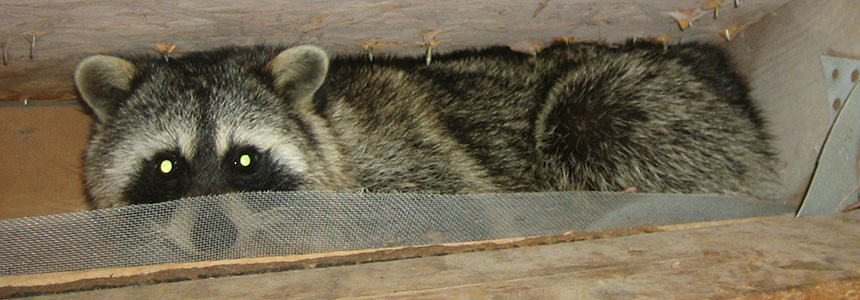
HUMANE HINTS
- Avoid cage trapping when possible. Raccoons in cages become stressed and can injure themselves. A trapped mother raccoon can be separated from its babies, who will then starve to death. Rather than trap, attempt to eliminate whatever is attracting the raccoon to your property. Bring pet food indoors, use fencing, bungee strap down the garbage can lids, seal the pet door, etc.
- If you must trap, and if a trap is set in the sun, they can deydrate and die of heat stroke. Always set the trap in a shady area, and check it diligently every morning, and relocate the animal as soon as possible.
- Relocation is stressful, on both the new animal and the existing animals in the area. Select your relocation point carefully, in an area with abundant resources and water.
- ALERT - if you have a raccoon in the attic, 90% of the time it is a female with a litter of babies. DO NOT simply trap the mother and remove her. The young in your attic will slowly starve to death over a period of up to two weeks, then decompose and cause an odor problem. Always be sure to find and remove the young as part of the process.
- You don't always have to physically remove raccoons in the attic or chimney. How to Remove a Wild Animal in the Chimney. Sometimes you can simply harass them out. Make your presence known, use raccoon eviction fluid scent, and the mother may move the young out on her own.
- Prevention is always the best when it comes to wildlife control. Be sure you have no openings or vulnerable areas on your home that allow animals inside. Don't leave out pet food or garbage or fruit on the ground, etc.
Wondering how to get rid of raccoons quickly and easily? There is no
magic spray or device that you can use to make them
go away. Some people try to sell predator urine,
such as coyote or fox urine to get rid of raccoons,
but that doesn't work. They also try to sell
ultrasonic sound emitters. These devices are
worthless at eliminating raccoons. Some old wives'
tales recommend the use of mothballs or
ammonia-soaked rags to make them leave, but I've
been to countless homes where these techniques
failed - biologists know that these attempts won't
work. The ONE AND ONLY WAY to take care of your
problem is with trapping
(tips here) and removal of the animals. If you
need to find a professional trapper in your
hometown, just click our comprehensive list
of hundreds of wildlife removal professionals,
and you can have your problem quickly taken care of!
Read more articles about raccoons:
Find out all you need to know about raccoons through my educational articles! Learn how to identify raccoon tracks and feces, and just how smart they are. Find out if raccoons swim, if they live in trees or sleep in trees, if they come out in the rainand how big raccoons get. Learn about whether or not raccoons can
climb fences, open doors or windows, burrow or dig holes, and just how far and high they can jump.
Read here about whether or not raccoons hibernate, and if they eat rodents. Learn if raccoons attack cats, dogs, or other pets, and whether they can be a danger to other animals. Perhaps our most important article to share is What to do if you are bitten by a raccoon.
How to get a raccoon out of a tree
Why do raccoons tear up sod? How to stop it
What are raccoons scared of?
How to scare a raccoon away
How To Get Rid Of Raccoons Without Killing Them
Raccoons in New York City
What kind of noises and sounds do raccoons make when they live in your house?
How to make a raccoon trap
How to hunt raccoons
Do female raccoons make good mothers?
How to get free raccoon removal
Do raccoons wash their food?
The Fastest Way To Get Rid Of Raccoons


















